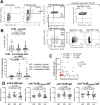Dysregulated Immunity to Clostridioides difficile in IBD Patients Without a History of Recognized Infection
- PMID: 37874904
- PMCID: PMC11063544
- DOI: 10.1093/ibd/izad238
Dysregulated Immunity to Clostridioides difficile in IBD Patients Without a History of Recognized Infection
Abstract
Background & aims: Clostridioides difficile is a toxin-secreting bacteria that is an urgent antimicrobial resistance threat, with approximately 25% of patients developing recurrent infections. Inflammatory bowel disease (IBD) patients are at increased risk of severe, recurrent C. difficile infection.
Methods: To investigate a role for C. difficile infection in IBD pathogenesis, we collected peripheral blood and stool from 20 each of ulcerative colitis patients, Crohn's disease patients, and healthy control subjects. We used a flow cytometric activation induced marker assay to quantify C. difficile toxin-specific CD4+ T cells and 16S ribosomal RNA sequencing to study microbiome diversity.
Results: We found IBD patients had significantly increased levels of C. difficile toxin B-specific CD4+ T cells, but not immunoglobulin G or immunoglobulin A, compared with healthy control subjects. Within antigen-specific CD4+ T cells, T helper type 17 cells and cells expressing the gut homing receptor integrin β7 were reduced compared with healthy control subjects, similar to our previous study of non-IBD patients with recurrent C. difficile infection. Stool microbiome analysis revealed that gut homing, toxin-specific CD4+ T cells negatively associated with microbial diversity and, along with T helper type 17 cells, positively associated with bacteria enriched in healthy control subjects.
Conclusions: These data suggest that IBD patients, potentially due to underlying intestinal dysbiosis, experience undiagnosed C. difficile infections that result in impaired toxin-specific immunity. This may contribute to the development of inflammatory T cell responses toward commensal bacteria and provide a rationale for C. difficile testing in IBD patients.
Keywords: C. difficile; CD4+ T cell; T cell memory; antimicrobial resistance; microbiome.
Plain language summary
Crohn’s disease and ulcerative colitis patients with no history of Clostridioides difficile infection had dysregulated T cell immunity to C. difficile toxin B. This was significantly different from healthy control subjects but similar to non–inflammatory bowel disease patients with recurrent C. difficile infection.
© 2023 Crohn’s & Colitis Foundation. Published by Oxford University Press on behalf of Crohn’s & Colitis Foundation.
Conflict of interest statement
M.K.L. has received research funding from Bristol Myers Squibb and Takeda for work not related to this study. T.S.S. has received research funding from Rebiotix, Seres, NuBiyota, Actelion, Sanofi Pasteur, and Pfizer for studies in
Figures



Similar articles
-
Analysis of Flagellin-Specific Adaptive Immunity Reveals Links to Dysbiosis in Patients With Inflammatory Bowel Disease.Cell Mol Gastroenterol Hepatol. 2020;9(3):485-506. doi: 10.1016/j.jcmgh.2019.11.012. Epub 2019 Nov 30. Cell Mol Gastroenterol Hepatol. 2020. PMID: 31790809 Free PMC article.
-
Oral Omilancor Treatment Ameliorates Clostridioides difficile Infection During IBD Through Novel Immunoregulatory Mechanisms Mediated by LANCL2 Activation.Inflamm Bowel Dis. 2024 Jan 5;30(1):103-113. doi: 10.1093/ibd/izad124. Inflamm Bowel Dis. 2024. PMID: 37436905
-
Recurrent Clostridioides difficile Infection Is Associated With Impaired T Helper Type 17 Immunity to C difficile Toxin B.Gastroenterology. 2021 Mar;160(4):1410-1413.e4. doi: 10.1053/j.gastro.2020.11.043. Epub 2020 Nov 27. Gastroenterology. 2021. PMID: 33253683 No abstract available.
-
Restoring the gut microbiome for the treatment of inflammatory bowel diseases.World J Gastroenterol. 2014 Apr 7;20(13):3468-74. doi: 10.3748/wjg.v20.i13.3468. World J Gastroenterol. 2014. PMID: 24707129 Free PMC article. Review.
-
[Clostridioides Infection in Patients with Inflammatory Bowel Disease].Korean J Gastroenterol. 2022 Aug 25;80(2):66-71. doi: 10.4166/kjg.2022.097. Korean J Gastroenterol. 2022. PMID: 36004633 Review. Korean.
References
Publication types
MeSH terms
Substances
Grants and funding
LinkOut - more resources
Full Text Sources
Medical
Research Materials


